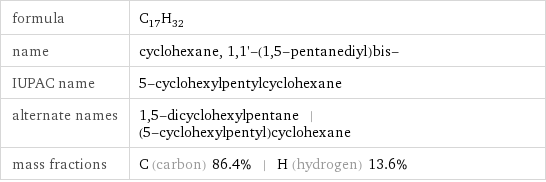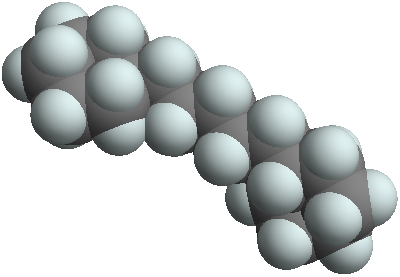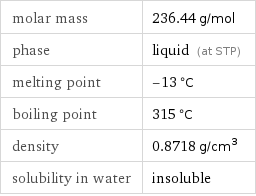Input interpretation

cyclohexane, 1, 1'-(1, 5-pentanediyl)bis-
Chemical names and formulas

formula | C_17H_32 name | cyclohexane, 1, 1'-(1, 5-pentanediyl)bis- IUPAC name | 5-cyclohexylpentylcyclohexane alternate names | 1, 5-dicyclohexylpentane | (5-cyclohexylpentyl)cyclohexane mass fractions | C (carbon) 86.4% | H (hydrogen) 13.6%
Lewis structure

Draw the Lewis structure of cyclohexane, 1, 1'-(1, 5-pentanediyl)bis-. Start by drawing the overall structure of the molecule: Count the total valence electrons of the carbon (n_C, val = 4) and hydrogen (n_H, val = 1) atoms: 17 n_C, val + 32 n_H, val = 100 Calculate the number of electrons needed to completely fill the valence shells for carbon (n_C, full = 8) and hydrogen (n_H, full = 2): 17 n_C, full + 32 n_H, full = 200 Subtracting these two numbers shows that 200 - 100 = 100 bonding electrons are needed. Each bond has two electrons, so the above diagram has all the necessary bonds. There are 50 bonds and hence 100 bonding electrons in the diagram. Lastly, fill in the remaining unbonded electrons on each atom. In total, there remain 100 - 100 = 0 electrons left to draw and the diagram is complete: Answer: | |
3D structure

3D structure
Basic properties

molar mass | 236.44 g/mol phase | liquid (at STP) melting point | -13 °C boiling point | 315 °C density | 0.8718 g/cm^3 solubility in water | insoluble
Units

Liquid properties (at STP)

density | 0.8718 g/cm^3 dynamic viscosity | 0.003879 Pa s (at 0 °C) refractive index | 1.479
Units

Thermodynamic properties

molar heat of fusion | 21 kJ/mol specific heat of fusion | 0.08882 kJ/g (at STP)
Chemical identifiers

CAS number | 54833-31-7 Beilstein number | 1340579 PubChem CID number | 143213 SMILES identifier | C1CCC(CC1)CCCCCC2CCCCC2 InChI identifier | InChI=1/C17H32/c1-4-10-16(11-5-1)14-8-3-9-15-17-12-6-2-7-13-17/h16-17H, 1-15H2